Expressing The Same Idea Through Art
Today I'm back with more artworks that worth writing about. One week ago I went to visit an art exhibition that had as theme celebrating 200 years from the birth of a well known Hungarian poet and revolutionary, Sándor Petőfi. As I mentioned in my first post, you need to know a bit of history in order to understand these artworks better, so that is why I'm going to explain what you see, to make it easier for you.

This acrylic painting is called Freedom, Love, which is the title of one of his poems.
Freedom, love!
I need these two.
I will sacrifice my life
For my love,
I will sacrifice my love
For freedom. source
And he did, literally. He was one of the key figures of the Hungarian Revolution of 1848. He disappeared (presumably died) during the battle of Segesvár by the Imperial Russian Army most likely 31 July 1849 . The interesting thing is many poets are writing revolutionary poems, but most likely he was one of the few who literally died as he said he would.
Now back to the painting, can you see freedom and love in this painting?
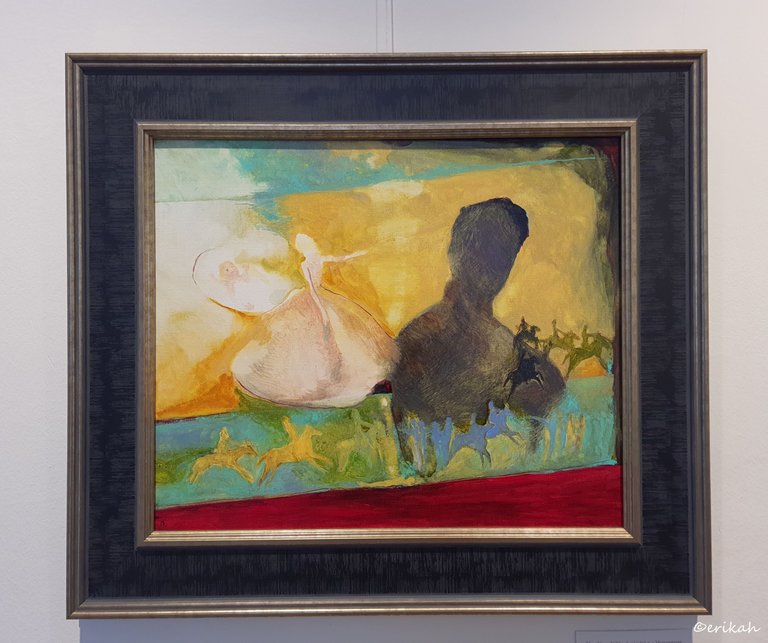
After seeing a few artworks, I could see the common, repetitive elements, which was the poet's either portrait or silhouette, mounted warriors and the flag. The flag is not visible here, but the rest is present. The lady in the background I suppose it is his wife, Júlia Szendrey.
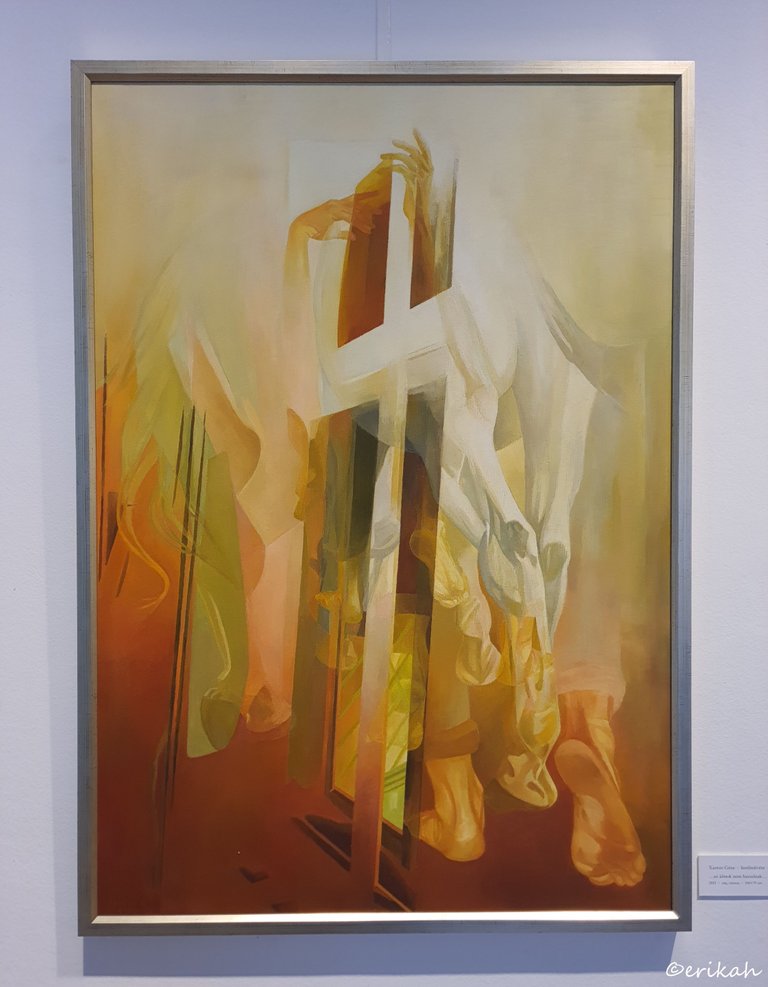
... dreams don't lie ...
I stood in front of this painting for a few minutes, trying to figure out what I'm seeing. I saw a man's feet, another set of feet, smaller or maybe it seems like it's smaller due to being a bit far, horse legs, a cross and hands that seem to be of a woman. I suppose dreams appear like this, a bit disorganized.
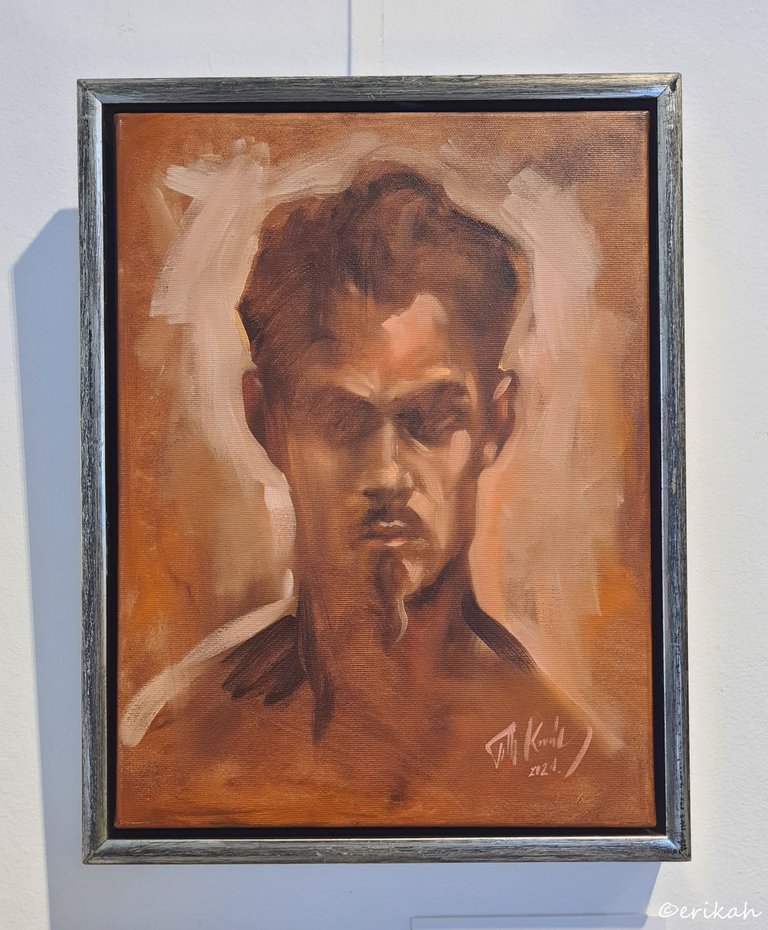
Of all the artworks I posted here, this was the one I liked the most, It's a rough oil portrait of the poet> What I like here is the tone of the painting and that it's not so detailed.

Dusk
Unusual, but very interesting. I like the shut eyes.
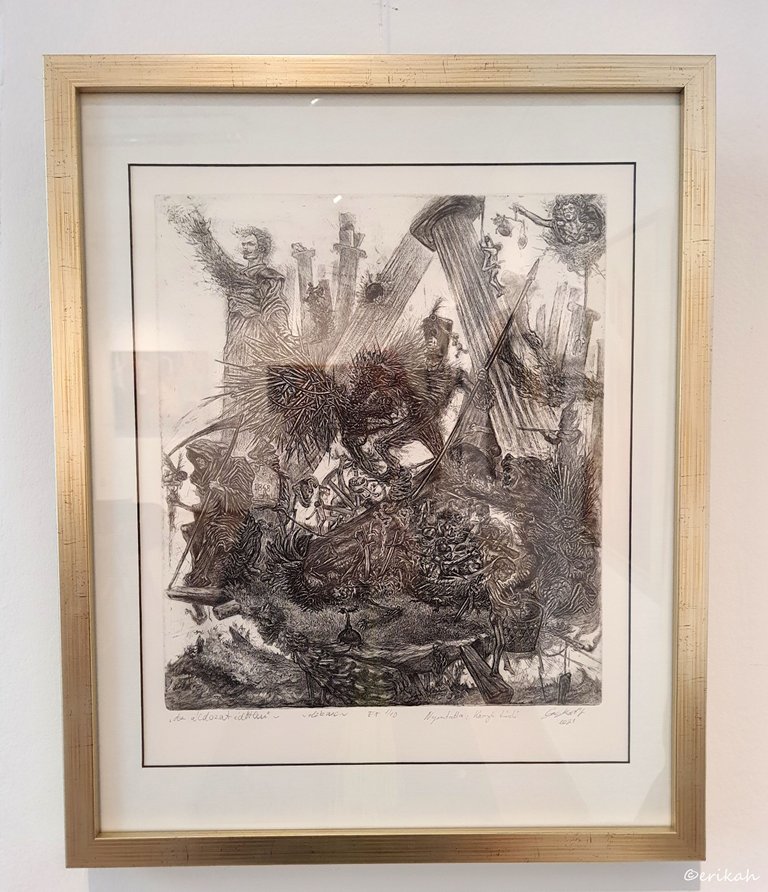
You know how exhibitions are. You see an artwork, you say you like it. Then you move on to the next one, you say you like that too and that's the best and your favorite. Then you move on and say about the next one that it's the best.
Sacrifice Is Timeless
Copper etching and paper.
Etching is traditionally the process of using strong acid or mordant to cut into the unprotected parts of a metal surface to create a design in intaglio (incised) in the metal. In modern manufacturing, other chemicals may be used on other types of material. As a method of printmaking, it is, along with engraving, the most important technique for old master prints, and remains in wide use today. In a number of modern variants such as microfabrication etching and photochemical milling it is a crucial technique in much modern technology, including circuit boards. source
I love this technique and I'm always fascinated about the details. My big problem is always the light and reflections and this is the reason you may not see that this artwork looks like.
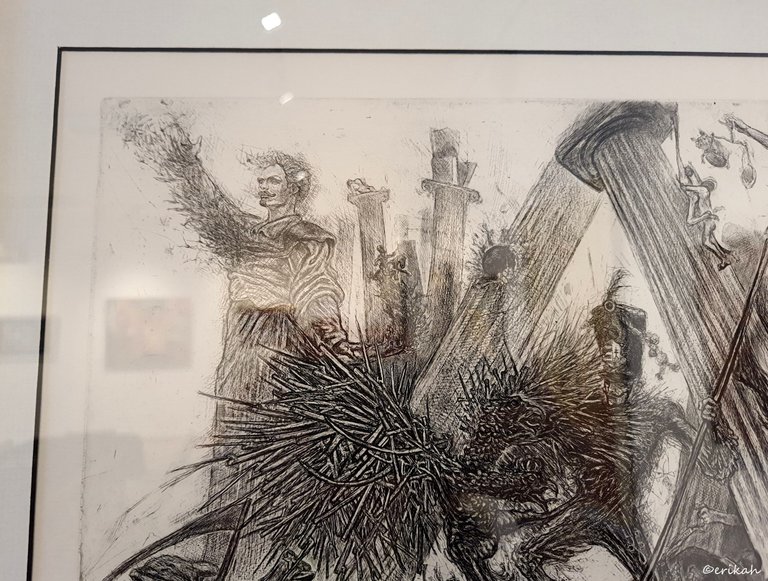
I took some partial photos to show you the details.
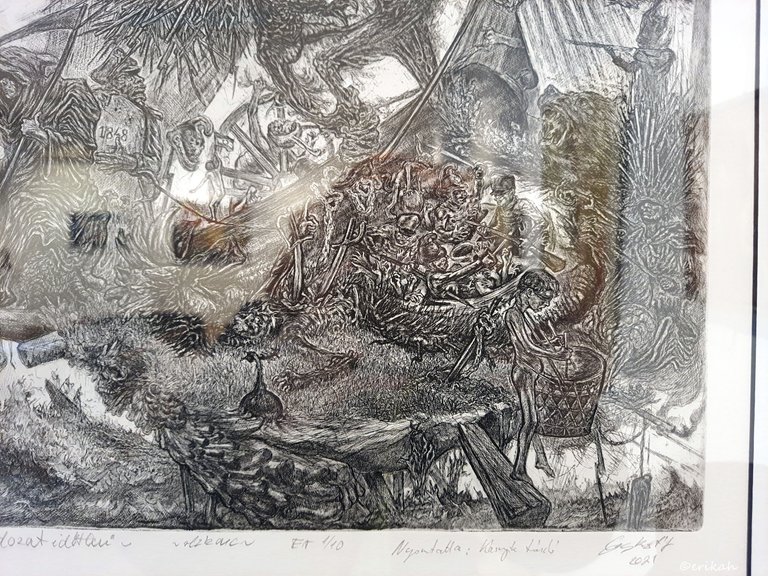
If you could no already figure out, the theme is the 1848's revolution.
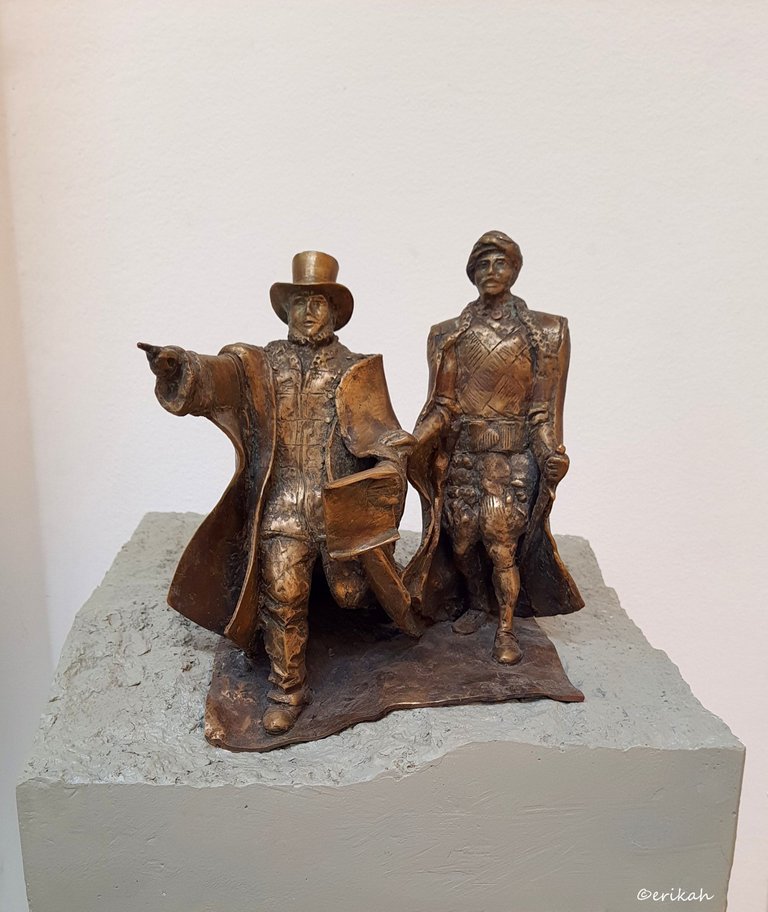
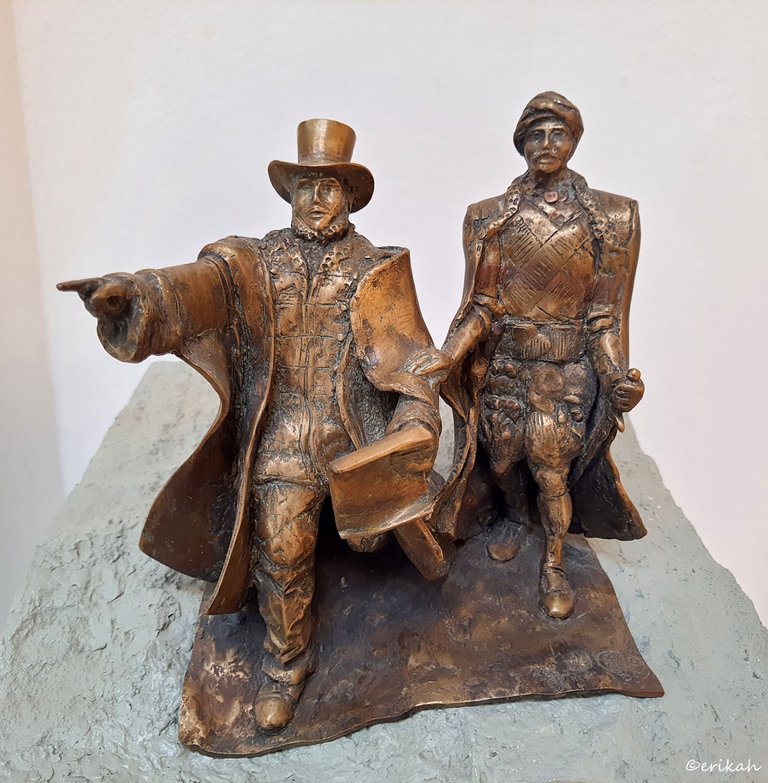
Another lovely bronze sculpture, that is featuring István Széchenyi, most likely holding the declaration of independence in his hand. It's a lovely sculpture. I was wondering how much this may cost.
Count István Széchenyi de Sárvár-Felsővidék, archaically English: Stephen Széchenyi; 21 September 1791 – 8 April 1860) was a Hungarian politician, political theorist, and writer. Widely considered one of the greatest statesmen in his nation's history, within Hungary he is still known to many as "the Greatest Hungarian". source

I must admit, I love these bronze sculptures. I'm not sure how difficult it is to create such a detailed work, but sure it is not easy. This gentleman looks so lifelike. The gentleman is Pál Teleki.
Count Pál János Ede Teleki de Szék (1 November 1879 – 3 April 1941) was a Hungarian politician who served as Prime Minister of the Kingdom of Hungary from 1920 to 1921 and from 1939 to 1941. He was also an expert in geography, a university professor, a member of the Hungarian Academy of Sciences, and chief scout of the Hungarian Scout Association. He descended from an aristocratic family from Transylvania. source
I'm a bit confused about this person as he was born after the poet disappeared, but the sculpture resembles and this gentleman is the only one Google gives me. The Teleki family is famous family in Transylvania's history, he's a count, so I suppose it's him.
I really enjoyed this exhibition, there were several pieces I liked.

If you're a newbie, you may want to check out these guides:
- Communities Explained - Newbie Guide
- Cross Posting And Reposting Explained, Using PeakD
- Hive Is Not For Me
- How To Pump Your Reputation Fast - Newbie Guide
- Tips And Tricks & Useful Hive Tools For Newbies
- More Useful Tools On Hive - Newbie Guide
- Community List And Why It Is Important To Post In The Right Community
- Witnesses And Proposals Explained - Newbie Guide
- To Stake, Or Not To Stake - Newbie Guide
- Tags And Tagging - Newbie Guide
- Newbie Expectations And Reality

These pieces of art are incredible.
Thanks for sharing.
Thank you for stopping by.
This post has been manually curated by @bhattg from Indiaunited community. Join us on our Discord Server.
Do you know that you can earn a passive income by delegating to @indiaunited. We share more than 100 % of the curation rewards with the delegators in the form of IUC tokens. HP delegators and IUC token holders also get upto 20% additional vote weight.
Here are some handy links for delegations: 100HP, 250HP, 500HP, 1000HP.
100% of the rewards from this comment goes to the curator for their manual curation efforts. Please encourage the curator @bhattg by upvoting this comment and support the community by voting the posts made by @indiaunited.
Thank you!
Very wonderful art exposition in honor of this poet, to be honest I didn't know about this story, but every day we learn something new like how poetic it is to be a revolutionary poet who knows how to capture about freedom, but unfortunately he has disappeared in a battle.
Something that I really liked about this post is to see what you commented about each painting and I tried to see what I could grasp from each one, it is very interesting how people persive different expressions in art.
You're right, we see things differently and interpret things differently.This is why we have so many category of art.
hola, gracias por presentarnos al artista y al poeta. Parece que la poesía de Sándor Petőfi está dedicada al amor, el paisaje y a su país.
You are right about that, he was a patriot in all regards.
I think I see a horse in this image. Or at the very least, elements of the horse's anatomy. There appears to be a pony tail, a head, and then various bits and pieces along the way. It reminds me in a way of another painting by Marcel Duchamp.
This painting is called "Nude Descending a Stair Case" - but it is an abstract, one that focuses on the discrete snapshots of motion from moment to moment, and the painting you shared and image of (and your thoughts upon) seems to reference this same concept of movement distilled into a single image.
How cool is that! I'm glad my photo and my thoughts reminded you of this painting. I don't know Marcel Duchamp or this painting, but I find it interesting.
Absolutely amazing artwork all pictures and sculptures I like, success is always there sir have a nice day
Thank you, I wish the same to you.
Thank you very much back
I love the mixture of colors in Freedom, Love, and the message behind its abstract that seems to fall deeply, maybe into the abyss of this patriot's love for his nation, he would die to reap freedom.
His painting says it all. Although a bit sad, I'm glad this piece is being displayed in the museum these days for the people to commemorate how he sacrificed his life for the nation to be free. A great artist and a true hero indeed!
Wait as these are not the poet's artworks. These were created by different artists. I said this in my first post and for got to specify it here. Sorry :)
All are incredible work of hands!😍 Amazing art! Thank you for sharing.
Thank you for stopping by.
My pleasure.☺️
Thank you very much for your explanations @erikah. Another really great exhibition. My favorite is the first photo. It has a mystical atmosphere and relaxes me. I usually don't like photos with a black background because it makes me feel dark, but this one is different and makes me feel good.
It was great indeed and you know how it is. You have a clear boundary about what you like and don't like, but life is funny that way as it gives you something different and you realize there's no clear line between what you like or don't like :)
It's been a while now I visited your page because of other activities outside this platform but I'm glad I did today. Knowing about Hungarian revolution is enough for me today, although I'm still going through the exciting exhibition visit. The art works are classic and good to feel. I just know those paintings has a strong message behind them. Wish I can read the message from the paintings. Thanks for those little explanation given under each painting and artwork. I love them
Reading the message of an artwork is a difficult task. I mean you think you understand it, they you read the title or speak to the artist and realize you missed it totally. But I wouldn't worry about that. Everyone understands things differently and if you like it, I think that should be enough.
Thank you 😊😊